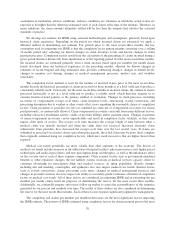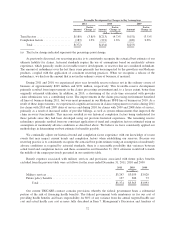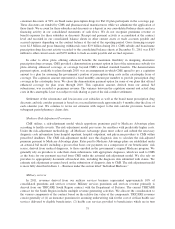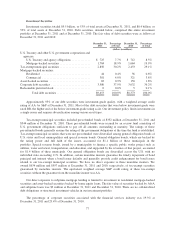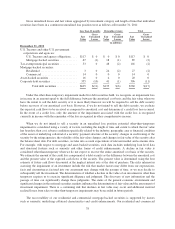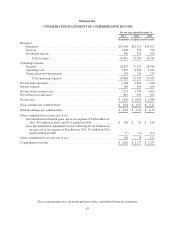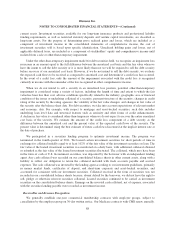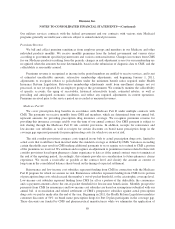Humana 2011 Annual Report Download - page 89
Download and view the complete annual report
Please find page 89 of the 2011 Humana annual report below. You can navigate through the pages in the report by either clicking on the pages listed below, or by using the keyword search tool below to find specific information within the annual report.mortgage-backed securities at December 31, 2011 primarily were composed of senior tranches having high credit
support, with 99% of the collateral consisting of prime loans. The weighted average credit rating of all
commercial mortgage-backed securities was AA at December 31, 2011.
Several European countries, including Spain, Italy, Ireland, Portugal, and Greece, have been subject to
credit deterioration due to weakness in their economic and fiscal situations. We have no direct exposure to
sovereign issuances of these five countries.
All issuers of securities we own that were trading at an unrealized loss at December 31, 2011 remain current
on all contractual payments. After taking into account these and other factors previously described, we believe
these unrealized losses primarily were caused by an increase in market interest rates and tighter liquidity
conditions in the current markets than when the securities were purchased. At December 31, 2011, we did not
intend to sell the securities with an unrealized loss position in accumulated other comprehensive income, and it is
not likely that we will be required to sell these securities before recovery of their amortized cost basis. As a
result, we believe that the securities with an unrealized loss were not other-than-temporarily impaired at
December 31, 2011.
There were no material other-than-temporary impairments in 2011, 2010, or 2009.
Goodwill and Long-lived Assets
At December 31, 2011, goodwill and other long-lived assets represented 23% of total assets and 51% of
total stockholders’ equity, compared to 23% and 55%, respectively, at December 31, 2010.
We are required to test at least annually for impairment at a level of reporting referred to as the reporting
unit, and more frequently if adverse events or changes in circumstances indicate that the asset may be impaired.
A reporting unit either is our operating segments or one level below the operating segments, referred to as a
component, which comprise our reportable segments. A component is considered a reporting unit if the
component constitutes a business for which discrete financial information is available that is regularly reviewed
by management. We are required to aggregate the components of an operating segment into one reporting unit if
they have similar economic characteristics. Goodwill is assigned to the reporting unit that is expected to benefit
from a specific acquisition. The realignment of our business segments and corresponding change in our
reportable segments, more fully described in Note 16 to the consolidated financial statements included in
Item 8.-Financial Statements and Supplementary Data, resulted in a change in the composition of our reporting
units. Accordingly, we reassigned goodwill to our reporting units as of January 1, 2011 using the relative fair
value approach based on an evaluation of future discounted cash flows as discussed in Note 8 to the consolidated
financial statements included in Item 8.-Financial Statements and Supplementary Data. A significant portion of
our historical goodwill was supported by future cash flows associated with our mail-order pharmacy and
behavioral health businesses now grouped with our Health & Well-Being Services businesses. This, in addition
with the Concentra acquisition on December 21, 2010, resulted in the allocation of a substantial portion of our
goodwill to the Health & Well-Being Services segment. We completed an interim impairment test as of
January 1, 2011 based on the new reporting units which did not result in an impairment loss.
We use a two-step process to review goodwill for impairment. The first step is a screen for potential
impairment, and the second step measures the amount of impairment, if any. Our strategy, long-range business
plan, and annual planning process support our goodwill impairment tests. These tests are performed, at a
minimum, annually in the fourth quarter, and are based on an evaluation of future discounted cash flows. We rely
on this discounted cash flow analysis to determine fair value. However outcomes from the discounted cash flow
analysis are compared to other market approach valuation methodologies for reasonableness. We use discount
rates that correspond to a market-based weighted-average cost of capital and terminal growth rates that
correspond to long-term growth prospects, consistent with the long-term inflation rate. Key assumptions in our
cash flow projections, including changes in membership, premium yields, medical and operating cost trends, and
certain government contract extensions, are consistent with those utilized in our long-range business plan and
79



